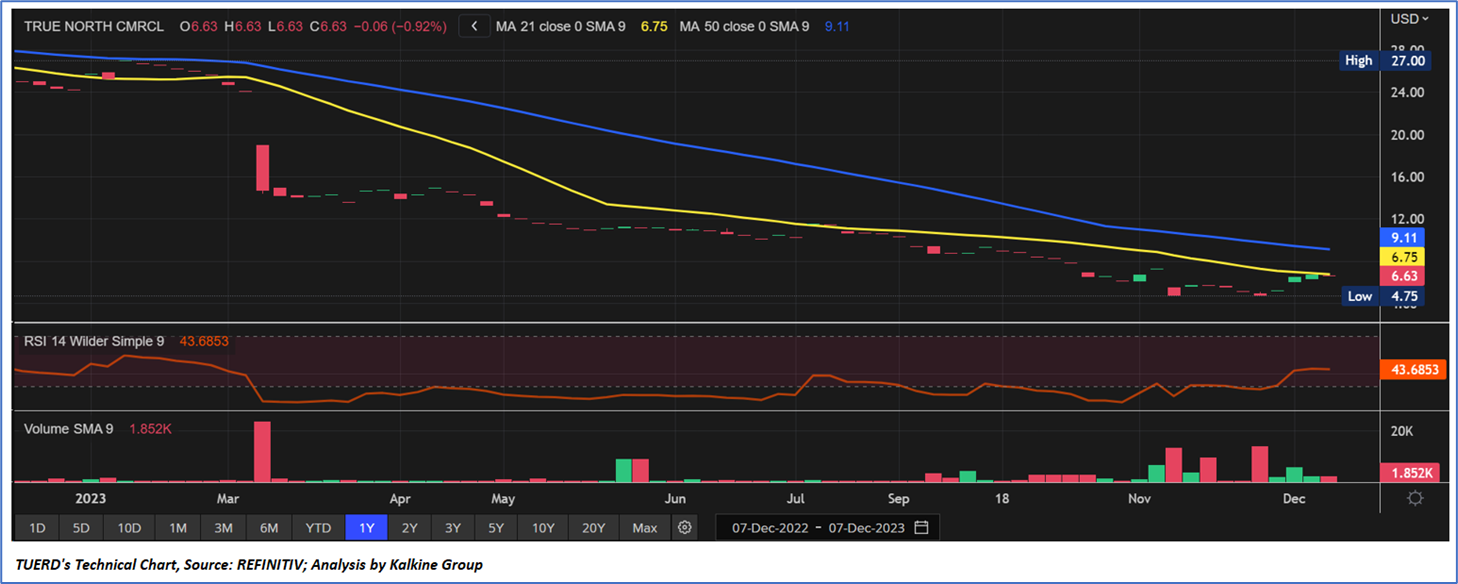
True North Commercial Real Estate Investment Trust
True North Commercial Real Estate Investment Trust (the REIT) (OTC: TUERD) is a Canada-based unincorporated, open-ended real estate investment trust. The REIT’s primary objective is to maximize total returns to its unitholders. Its returns include a stable, reliable, and tax-efficient monthly cash distribution as well as long-term appreciation in the value of its units through the effective management of a portfolio of commercial properties.

Recent Financial and Business Updates:
Third Quarter 2023 Highlights: In Q3 2023, the real estate investment trust (REIT) maintained a robust portfolio occupancy rate of 93%, boasting an average remaining lease term of 4.4 years (91% and 4.4years including investment properties held for sale). Notable property transactions included the sale of the Laurier Property in Ottawa, totalling 107,100 square feet, for USD 17.5 million on July 10, 2023, and the sale of the Abbotsford Property in BC, totalling 52,300 square feet, for USD 24.0 million on July 31, 2023. The REIT successfully leased and renewed approximately 86,900 square feet, with a weighted average lease term of 7.7 years and a 1.5% increase over expiring base rents. However, excluding termination income and investment properties held for sale, revenue, and net operating income (NOI) experienced a 1% and 4% decrease, respectively, compared to Q3-2022. Same Property NOI decreased by 1.6% (excluding investment properties held for sale and termination fees). Notably, the REIT received termination income from a tenant in 2022, impacting Q3-2023 FFO and AFFO basic and diluted per Unit.
Year-to-Date (YTD) Highlights: In the broader context, the REIT accomplished the sale of the Carling view Property in Toronto, generating USD 7.25 million on March 10, 2023. Contractually leasing and renewing approximately 512,800 square feet, the REIT observed a weighted average lease term of 5.0 years and an 11% increase over expiring base rents. The strategic decision to repurchase 208,400 Units under the Normal Course Issuer Bid (NCIB) for USD 0.5 million contributed to financial management. A significant move during the year was the 50% reduction in the monthly cash dividend, enhancing the REIT's capital profile by providing an additional USD 25 million in cash annually. Additionally, a noteworthy executive transition occurred, with Tracy Sherren retiring from her executive positions, leaving Martin Liddell to assume the role of Chief Financial Officer of the REIT.
Subsequent Events: Following the quarter, the REIT secured a three-year term refinancing for a USD 3,834 mortgage, demonstrating proactive financial management. The REIT's ability to adapt its strategy in response to market dynamics and optimize its portfolio reflects a commitment to sustaining growth and ensuring a robust financial future.
Technical Observation (on the daily chart)
The Relative Strength Index (RSI) over a 14-day period stands at 43.68, currently recovering from oversold zone, with expectations of some consolidation. Moreover, the price is currently positioned below both the 21-day SMA and 50-day SMA trend-following indicators, which may act as dynamic short-term resistance levels.


Individuals can evaluate the stock based on the support and resistance levels provided in the report in case of keen interest taking into consideration the risk-reward scenario.
Markets are trading in a highly volatile zone currently due to certain macro-economic issues and prevailing geopolitical tensions. Therefore, it is prudent to follow a cautious approach while investing.
Related Risk: This report may be looked at from a high-risk perspective and a recommendation is provided for a short duration. This report is solely based on technical parameters, and the fundamental performance of the stocks has not been considered in the decision-making process. Other factors which could impact the stock prices include market risks, regulatory risks, interest rates risks, currency risks, social and political instability risks etc.
How to Read the Charts?
The yellow colour line reflects the 21-period simple moving average (SMA) while the blue line indicates the 50- period simple moving average (SMA). SMA helps to identify existing price trends. If the prices are trading above the 21-period and 50-period moving average, then it shows prices are currently trading in a bullish trend.
The orange colour line in the chart’s lower segment reflects the Relative Strength Index (14-Period) which indicates price momentum and signals momentum in trend. A reading of 70 or above suggests overbought status while a reading of 30 or below suggests an oversold status.
The red and green colour bars in the chart’s lower segment show the volume of the stock. The volume is the number of shares that changed hands during a given day. Stocks with high volumes are more liquid than stocks with lesser volume as liquidity in stocks helps with easier and faster execution of the order.
The Orange colour lines are the trend lines drawn by connecting two or more price points and used for trend identification purposes. The trend line also acts as a line of support and resistance.
Technical Indicators Defined: -
Support: A level at which the stock prices tend to find support if they are falling, and a downtrend may take a pause backed by demand or buying interest. Support 1 refers to the nearby support level for the stock and if the price breaches the level, then Support 2 may act as the crucial support level for the stock.
Resistance: A level at which the stock prices tend to find resistance when they are rising, and an uptrend may take a pause due to profit booking or selling interest. Resistance 1 refers to the nearby resistance level for the stock and if the price surpasses the level, then Resistance 2 may act as the crucial resistance level for the stock.
Stop-loss: It is a level to protect further losses in case of unfavourable movement in the stock prices.
The reference date for all price data, currency, technical indicators, support, and resistance levels is December 08, 2023. The reference data in this report has been partly sourced from REFINITIV.
Abbreviations
CMP: Current Market Price
SMA: Simple Moving Average
RSI: Relative Strength Index
USD: United States dollar
Note: Trading decisions require a thorough analysis by individual. Technical reports in general chart out metrics that may be assessed by individuals before any stock evaluation. The above are illustrative analytical factors used for evaluating the stocks; other parameters can be looked at along with additional risks per se. Past performance is neither an indicator nor a guarantee of future performance.
The advice given by Kalkine Canada Advisory Services Inc. and provided on this website is general information only and it does not take into account your investment objectives, financial situation and the particular needs of any particular person. You should therefore consider whether the advice is appropriate to your investment objectives, financial situation and needs before acting upon it. You should seek advice from a financial adviser, stockbroker or other professional (including taxation and legal advice) as necessary before acting on any advice. Not all investments are appropriate for all people. The website www.kalkine.ca is published by Kalkine Canada Advisory Services Inc. The link to our Terms & Conditions has been provided please go through them. On the date of publishing this report (mentioned on the website), employees and/or associates of Kalkine do not hold positions in any of the stocks covered on the website. These stocks can change any time and readers of the reports should not consider these stocks as advice or recommendations later.